Inside The New York Botanical Garden
Programs and Events
Posted in Programs and Events on October 23 2009, by Plant Talk
Plus Poetry Readings, Bird Walk, Greenmarket, and Kiku
Celebrate the thrills and chills of the season at The New York Botanical Garden’s Halloween Hoorah! on Sunday. Come in your costume or make your own mask here and parade around the grounds. Follow the trail on your Halloween map and participate in hands-on activities along the route. End the day learning about bats during a live animal demonstration.
On Saturday, listen to poets read their favorites as well as their own works inspired by nature, go on a bird walk, and shop at the Greenmarket. And on both days of the weekend, visit Kiku in the Japanese Autumn Garden, see taiko drumming performances, and more.
Get Your Tickets |
Posted in Programs and Events on October 9 2009, by Plant Talk
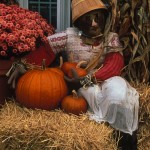 Enjoy the delights of the harvest season all day each day of this Columbus holiday weekend. In the Everett Children’s Adventure Garden, see apples pressed into cider, make applesauce, create apple prints in a field notebook, and scavenge the grounds for fruit and seeds that other animals harvest. In the Ruth Rea Howell Family Garden, participate in a corn-husking contest and build a scarecrow. Enjoy the delights of the harvest season all day each day of this Columbus holiday weekend. In the Everett Children’s Adventure Garden, see apples pressed into cider, make applesauce, create apple prints in a field notebook, and scavenge the grounds for fruit and seeds that other animals harvest. In the Ruth Rea Howell Family Garden, participate in a corn-husking contest and build a scarecrow.
For more fun events Saturday, Sunday, and Monday, see our calendar listings at Plan Your Visit. Get Your Tickets
|
Posted in Programs and Events on October 2 2009, by Plant Talk
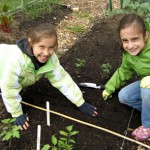 Help prepare the Ruth Rea Howell Family Garden for winter. During Goodnight, Garden!, plant cover crops, bury bulbs before the frost, or grab a rake to gather the fallen leaves. Sketch a still life of the fabulous fall fruits and frame it with super seeds. Make your very own marigold jewelry. Tuesdays–Sundays, 1:30–5:30 p.m., through November 1 Help prepare the Ruth Rea Howell Family Garden for winter. During Goodnight, Garden!, plant cover crops, bury bulbs before the frost, or grab a rake to gather the fallen leaves. Sketch a still life of the fabulous fall fruits and frame it with super seeds. Make your very own marigold jewelry. Tuesdays–Sundays, 1:30–5:30 p.m., through November 1
Get Your Tickets |
Posted in Programs and Events, Science on October 1 2009, by Plant Talk
NYBG Hosts Free Presentation on the History of Amateur Mycology
 |
Brian M. Boom, Ph.D., is President of the Torrey Botanical Society and Director of the Caribbean Biodiversity Program at The New York Botanical Garden.
|
Founded in 1867 in New York City, the Torrey Botanical Society is the oldest botanical association in the Americas. Throughout its long, distinguished history of promoting interest in botany and in disseminating information about all aspects of plants and fungi, among the most important of the Society’s activities is its lecture series. Each year, a lecture is presented in October, November, December, March, April, and May, and the schedule is posted through the Society’s Web site. The lectures are free and open to the public. Refreshments precede each lecture.
The first Torrey lecture of this season is on Tuesday, October 6, at 6:30 p.m. in the Arthur and Janet Ross Lecture Hall at The New York Botanical Garden. David W. Rose, archivist, writer, and past president of the Connecticut-Westchester Mycological Association, will present Great Goddess of Decay! A History of Amateur Mycology in the United States. You can read his abstract online.
In addition to hosting the lecture series, the Society publishes a scholarly journal (The Journal of the Torrey Botanical Society), organizes numerous field trips to local sites of botanical and mycological interest, and offers a series of grants and awards to support field work and seminars. I invite you to come to the October 6 lecture and to meet fellow plant and fungi enthusiasts.
Posted in Programs and Events on September 25 2009, by Plant Talk
 Throughout the Everett Children’s Adventure Garden, New York City Ballet educators and School of American Ballet dancers introduce families to ballet choreography and guide children three years of age and older in the creation of dances inspired by the garden. Ballet Among the Blooms takes place Saturday, from 3 to 5 p.m., and includes a lecture-demonstration; a visual arts and crafts area; and workshop stations where NYC Ballet Teaching Artists will lead children in movement activities based on site-specific surroundings. Get Your Tickets Throughout the Everett Children’s Adventure Garden, New York City Ballet educators and School of American Ballet dancers introduce families to ballet choreography and guide children three years of age and older in the creation of dances inspired by the garden. Ballet Among the Blooms takes place Saturday, from 3 to 5 p.m., and includes a lecture-demonstration; a visual arts and crafts area; and workshop stations where NYC Ballet Teaching Artists will lead children in movement activities based on site-specific surroundings. Get Your Tickets |
Posted in Exhibitions, Programs and Events, The Edible Garden on September 4 2009, by Plant Talk
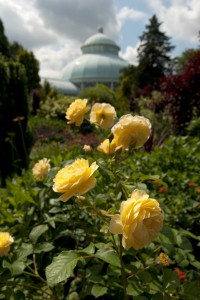
With the beautiful weather and a three-day respite from work (for most), this is a great time to get away to the Botanical Garden—and without going far. Enjoy the waning days of summer viewing the lush Perennial Garden, Seasonal Walk, and Rose Garden. Catch The Edible Garden in its penultimate weekend with tours, cooking demos, children’s activities, and more. Take a bird walk or attend the Greenmarket on Saturday, enjoy poetry readings on Sunday, relax on a Tram Tour of the Garden’s 250-acres on Monday (or any day). You can do all these wonderful things with an All-Garden Pass.
|
Posted in Exhibitions, Programs and Events, The Edible Garden on September 4 2009, by Plant Talk
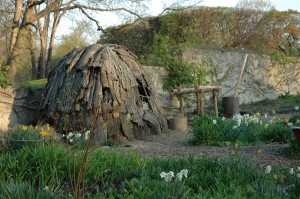 A few weeks ago, during one of many rainstorms in the Ruth Rea Howell Family Garden this summer, I took refuge with a few students from our Children’s Gardening Program in the wigwam tucked in the side corner of the garden’s Meadow. While the kids played giddy musical chairs on the stumps inside, I sat quietly with my back against the bark wall. It’s a cozy space. Although the kids were acting loud and giggly, the small wigwam felt peaceful. The rain fell near-noiselessly on the dome of birch saplings. Through the wigwam’s single window, daylilies and tall zebra grass shone orange and green against the gray.
A few weeks ago, during one of many rainstorms in the Ruth Rea Howell Family Garden this summer, I took refuge with a few students from our Children’s Gardening Program in the wigwam tucked in the side corner of the garden’s Meadow. While the kids played giddy musical chairs on the stumps inside, I sat quietly with my back against the bark wall. It’s a cozy space. Although the kids were acting loud and giggly, the small wigwam felt peaceful. The rain fell near-noiselessly on the dome of birch saplings. Through the wigwam’s single window, daylilies and tall zebra grass shone orange and green against the gray.
Part of the Three Sisters display garden, the wigwam was built in 2006 to re-create the lifestyle of the Lenni-Lenape, the first New York natives. When teaching, I often ask my students to imagine what it would be like to live as the Lenape did 400 years ago. I ask the children to think about everything they do inside their homes—cook, read, watch TV, play with toys, take refuge in air conditioning when the summer hits—and think of what the Lenape would be doing instead. With seven-year-olds, of course, a reflective discussion like this leads to hilarity pretty quickly.
But after some groans and giggles about sharing a bedroom with your whole family, comparing lifestyles leads to an epiphany as well. The wigwam only seems small in comparison to today’s houses when you think about it as an equal living environment. But it isn’t. In those early, pre-hustle-and-bustle New York years, an entire world around the home provided the space for cooking, playing, harvesting. (Who needs air conditioning with the Bronx River running so close by?) What I like about the wigwam is its clear definition of necessity. It’s a space of shelter and sleep. Imagination provides the rest.
Read More
Posted in Programs and Events, Wildlife on September 3 2009, by Plant Talk
Join Debbie Becker in Looking for Early Migrants
 |
Debbie Becker leads a free bird walk at the Garden every Saturday from 11 a.m. to 12:30 p.m. beginning at the Reflecting Pool in the Leon Levy Visitor Center.
|
 While the spring migration is exciting because of the colorful warblers that come through, the fall migration is much more spectacular in other ways. The warblers pass through again, but in drabber colors.
While the spring migration is exciting because of the colorful warblers that come through, the fall migration is much more spectacular in other ways. The warblers pass through again, but in drabber colors.
But it is the hawks, owls, harriers, ospreys, eagles, sparrows, swifts, swallows, and shorebirds on the move that attract most of the attention of bird watchers. The migration begins in late July, when the shorebirds begin showing up on coastal beaches. Osprey follow as they move south to open water. By mid-to-late August we see other species also migrating such as dragonflies and monarch butterflies. By September, the skies will be filled with their movement as well as of swifts and swallows.
As the last days of summer approach in mid-September and heat thermals rise off the Earth, the hawk migration will be in full swing. The hawks use the warm thermals to soar and conserve energy. A good thermal can allow a hawk to coast for miles. Broad-winged hawks are notorious for gliding on thermals in groups of thousands, known as “kettles,” during their migration from North America to South America.
Ruby-throated hummingbirds frequent the Garden during September as the jewelweed comes into bloom, filling their bellies with sweet nectar for the return trip to their wintering grounds. A hummingbird can fly nonstop up to 24 hours and almost 600 miles on stored fat.
Read More
Posted in Exhibitions, Learning Experiences, Programs and Events, The Edible Garden on August 21 2009, by Plant Talk
 |
Toby Adams is Manager of the Ruth Rea Howell Family Garden. |
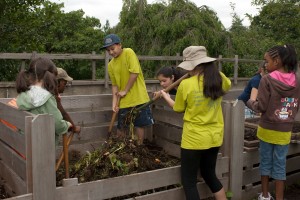 Vegetables and kids: two of my favorite things, growing together in the Ruth Rea Howell Family Garden! Each year we open the gates of our one-and-a-half-acre garden to thousands of children and invite them to help us in our annual effort to grow thousands of plants.
Vegetables and kids: two of my favorite things, growing together in the Ruth Rea Howell Family Garden! Each year we open the gates of our one-and-a-half-acre garden to thousands of children and invite them to help us in our annual effort to grow thousands of plants.
Sitting here now, among the tangles of tomato vines heavy with fruit and rows of sunflowers standing tall, it takes a leap of faith to believe this site was nearly bare when we began. Only a short time ago, I’m certain I was sitting in this same spot bundled in countless layers of thermal fabric with my eyes closed imagining the fragrances that envelope me now, straining to hear the drones of the pollinators patrolling the plots, and wondering at what point in the summer the garlic leaves would collapse under the weight of themselves.
A little over one hundred days later, my imaginations have been realized. The freshly harvested basil leaves stain fingers with their pungent perfume, the bees are busy buzzing in and out of the squash blossoms, and the garlic has already been harvested, braided, and hung in the garage to cure.
Read More
Posted in Exhibitions, Programs and Events, The Edible Garden on August 14 2009, by Plant Talk
Uses Architecture as Model, Seasonal Foods as Inspiration
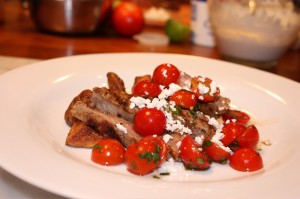 I am very happy to see the public turning the tide on the recent bad food trends and diets and embracing a seasonal-foods lifestyle. On my Web site, Harvest Eating.com, I have been promoting the idea of cooking with seasonal ingredients for roughly five years now. I have seen the interest in my work reach a fever pitch this year as people are truly attempting to change their eating habits to a more sustainable and community-based approach that includes plenty of local sourcing. This is fantastic and shows that the public is paying close attention to the chefs that are leading the movement. I’d like to think I am among the chefs making a difference in this area.
I am very happy to see the public turning the tide on the recent bad food trends and diets and embracing a seasonal-foods lifestyle. On my Web site, Harvest Eating.com, I have been promoting the idea of cooking with seasonal ingredients for roughly five years now. I have seen the interest in my work reach a fever pitch this year as people are truly attempting to change their eating habits to a more sustainable and community-based approach that includes plenty of local sourcing. This is fantastic and shows that the public is paying close attention to the chefs that are leading the movement. I’d like to think I am among the chefs making a difference in this area.
In preparation for my appearance tomorrow at The Edible Garden, I had been contemplating what my demonstration should comprise. There are plenty of chefs who give rock-star demonstrations that show off their skills in all sorts of culinary focuses, including seasonal cooking. However, I am trying to do something different this time. I want to grant access into the part of my brain that allows me to create recipes. I don’t think enough chefs, or any for that matter, attempt to teach the art of “recipe creation” to the people they encounter at demonstrations or other public events. I will attempt to change that on August 15 in NYC.
I believe that most “foodies” don’t give their own senses enough credit. Most people know what good food looks like, smells like, and tastes like, yet if you ask them to create a recipe without the aid of a cookbook, things go astray. The prospect of creating recipes for most people is daunting. That was the case for me as well for many years. It was only later in my career in food that I became a prolific creator of great recipes. Anybody can create a recipe, right? Let’s see…how about smoked salmon and peanut butter yogurt with chopped onions and grapes? Does not sound too good, huh?
To create great recipes, you need some guidelines, some boundaries, and some building blocks of knowledge to judge the combination of flavors, textures, and smells. You are attempting to create balance.
Read More














